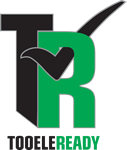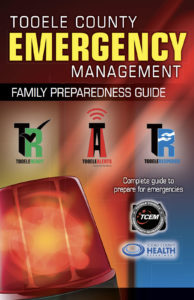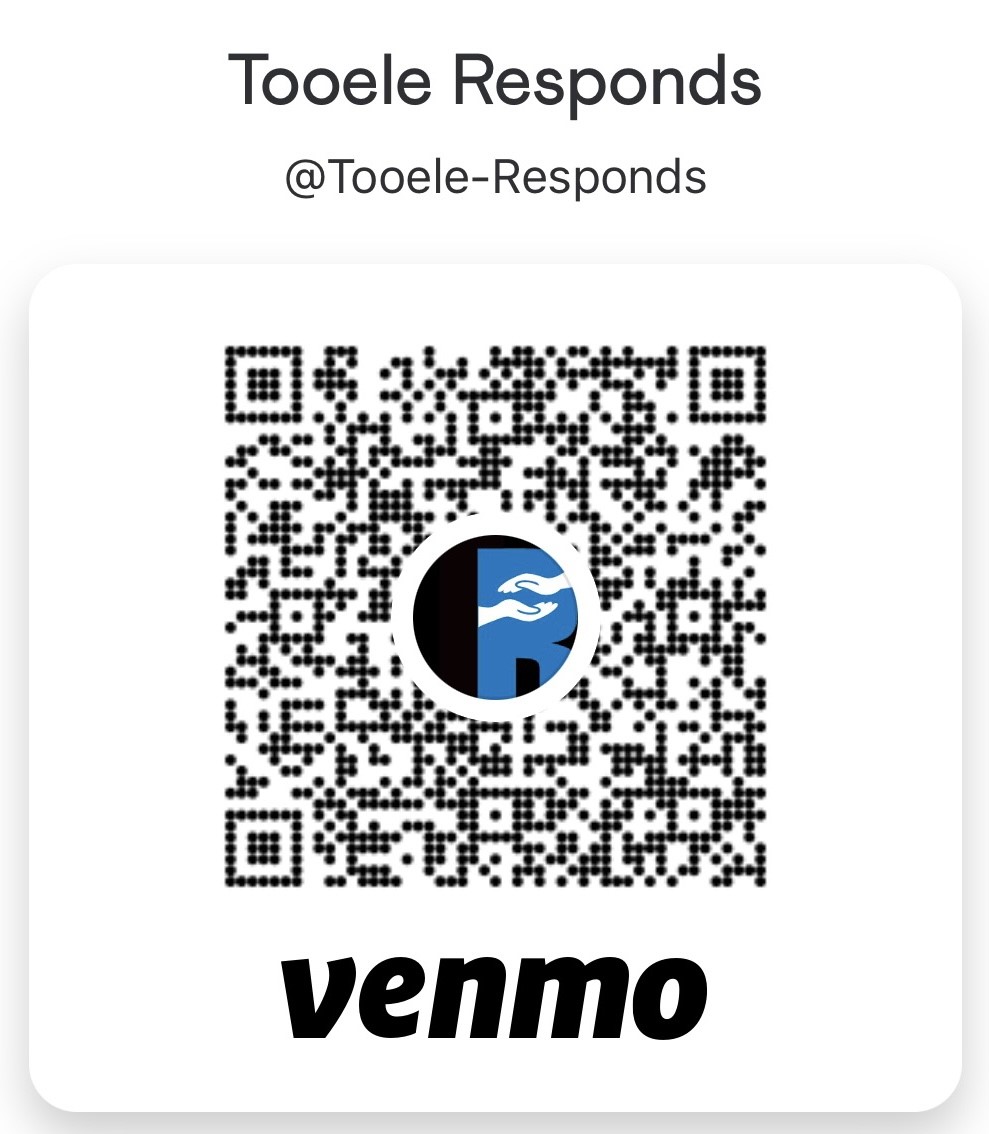Make a Plan
Disasters Happen Anytime and Anywhere
DISASTERS HAPPEN ANYTIME & ANYWHERE.
When disaster strikes, you may not have much time to respond. A hazardous material spill could mean evacuation. A winter storm could confi ne your family at home. An earthquake, fl ood, windstorm, or any other disaster could cut water, electricity, gas, sanitation, and telephone for days. After a disaster, local offi cials and relief workers will be on the scene, but they cannot reach everyone immediately. The professional first responders will go to where major fi res or transportation issues are. You could get help in hours, but more likely, it may take days for professional fi rst responders to come to your neighborhood. Would your family be prepared to cope with the emergency until help arrives? Your family will cope best by preparing for disaster before it strikes. The best way to prepare is by creating a Family Disaster Plan and assembling an Emergency Supplies Kit. Once disaster hits you won’t have time to shop or search for supplies. But if you have gathered supplies in advance, your family can bear an evacuation or home confi nement with greater ease. You should be prepared to take care of yourself and your family for a minimum of 4 days. Learn how quick
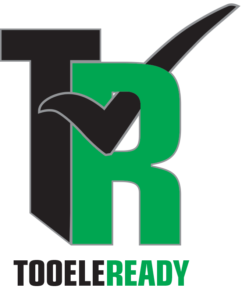 and easy it is to become better prepared to face a range of emergencies anytime, anywhere. Use guide to create your own emergency plan. Use the checklists to build emergency supplies, a first aid kit, and an important documents kit. Learn about the hazards and disasters that might affect your family and then prepare accordingly. These basic steps will help you take care of yourself and your loved ones during an emergency.
and easy it is to become better prepared to face a range of emergencies anytime, anywhere. Use guide to create your own emergency plan. Use the checklists to build emergency supplies, a first aid kit, and an important documents kit. Learn about the hazards and disasters that might affect your family and then prepare accordingly. These basic steps will help you take care of yourself and your loved ones during an emergency.Personal and Family Readiness
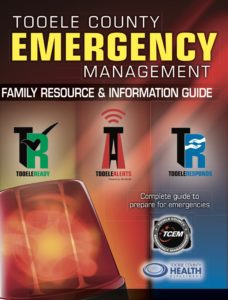 Families can and do cope with disaster by preparing in advance and working together as a team. Knowing what to do is your best protection and your responsibility: Questions to start asking:
Families can and do cope with disaster by preparing in advance and working together as a team. Knowing what to do is your best protection and your responsibility: Questions to start asking:
- Where will your family be when disaster strikes? (They could be anywhere—at work, at school or in the car.)
- How will you find each other?
- How will you know if everyone is safe?
- How will we be able to communicate with each other?
- How will we get information about the disaster?
- Who might be able to help us?
- Who might we be able to help?
- Where will we go if we have to leave?
- What if we cannot get home?
- What supplies are the very most important for our comfort and safety?
In a disaster, you don’t rise to the occasion, you sink to your lowest level of preparedness. Your level of preparation will determine your reaction to whatever event happens and how well you will recover.
Create a Disaster Readiness Plan
- Meet with your family and discuss why you need to prepare for disaster.
- Explain the dangers of fire, severe weather, and earthquakes to children. Plan to share responsibilities and work together as a team.
- Discuss the types of disasters that are most likely to happen. Explain what to do in each case.
- Develop a plan to communicate. Ask an out-of-state person to be your “family contact.” After a disaster, it’s often easier to call long distance. Other family members should call or text this person and tell them where they are and their condition. Everyone must know your contact’s phone number.
Make sure everyone knows how to text. Know how you will receive emergency messages from authorities.
Who we should call to let all our family know we are safe

Know how you will communicate with neighbors, school, work, and others. Learn about the Red Cross Safe and Well Program at www.redcross.org/safeandwell to communicate with loved ones after a disaster. Send text messages instead of phone calls because text messages may get through better.
- Post emergency telephone numbers by phones (fire, police, ambulance, etc.)
- Teach family members when to call 911 and what to say.
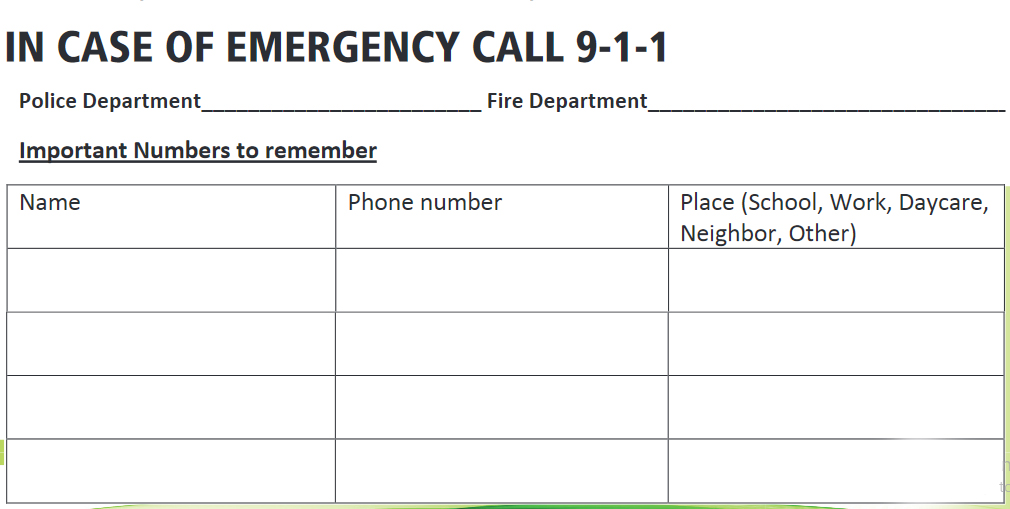
- Discuss what to do in an evacuation. Pick two places to meet: 1. Right outside your home in case of a sudden emergency, like a fi re. 2. Outside your neighborhood in case you can’t return home. Everyone must know the address and how to get there. Determine the best escape routes from your home. Find two ways out of each room.
TWO MEETING PLACES FOR OUR FAMILY TO REUNITE.
- In the Neighborhood: _____________________________
- Outside of the neighborhood: ______________________
- Be familiar with names of roads and know designated evacuation routes. Keep a map of the local area with this plan.
- Be familiar with warning systems. Sign up to get alerts and notifi cations from Emergency Management.
- Show family members how and when to shut utilities off and where utility shut offs are.
- Install smoke detectors on each level of the home, especially near bedrooms. Check smoke detectors and carbon monoxide detectors regularly.
- Conduct a home hazard hunt. Mitigate potential hazards and risks
- Find the safe spots in your home for each type of disaster.
- Know who in your neighborhood might need help in preparing and responding in a disaster and include them in your plans. Know who, in your neighborhood, that could help your family.
Neighbors that might need our help

Learn about the emergency evacuation plans for your workplace and what you will need to do. You may want to have some basic supplies at work, such as water and food that won’t spoil, in case you need to stay put for a while. Check with your employer about workplace emergency plans, including fi re alarms, emergency exits, meeting points, and designated safety personnel or floor wardens
Ask your children’s school or daycare about their emergency policies. Find out how they will contact families during an emergency. Find out what type of authorization the school or daycare requires to release your children to a designated person if you can’t pick them up. Make sure the school or daycare has updated contact information for parents, caregivers, and designated persons.
Planning for Pets and Animals
 Make plans for your pets and animals. In case of an evacuation, remember that pets are not allowed in public shelters or some hotels. Arrange a safe-haven for your pets in the event of evacuation. DO NOT LEAVE YOUR PETS BEHIND. Remember, if it isn’t safe for you, it isn’t safe for your pets. They may become trapped or escape and be exposed to numerous life-threatening hazards. It is imperative that you have determined where you will bring your pets ahead of time:
Make plans for your pets and animals. In case of an evacuation, remember that pets are not allowed in public shelters or some hotels. Arrange a safe-haven for your pets in the event of evacuation. DO NOT LEAVE YOUR PETS BEHIND. Remember, if it isn’t safe for you, it isn’t safe for your pets. They may become trapped or escape and be exposed to numerous life-threatening hazards. It is imperative that you have determined where you will bring your pets ahead of time:
- Contact your veterinarian for a list of preferred boarding kennels and facilities.
- Ask your local animal shelter if they provide emergency shelter or foster care for pets.
- Identify hotels or motels outside of your immediate area that may accept pets.
- Ask friends and relatives outside your immediate area if they would be willing to take in your pet.
Pet/Animal Information

Insurance Information


- Compile a home inventory. Update it often. Compiling a comprehensive home inventory takes time and effort, but the more detailed the inventory is, the more useful it will be if you have to make a claim.
- Document the possessions inside and outside of your home and make sure to check with your agent to confirm those possessions and property would be covered by your policy.
- Keep your home inventory in a safe place. Creating an inventory is important, but if that inventory is destroyed along with all your belongings it did you no good. Keep copies off site or stored in a cloud-based service.
- Read your policy before a loss occurs. Know what is covered, what is not, and the limitation of the policy.
Consider different types of insurances for different needs, such as earthquake and fl ood insurance, which are not covered in most basic insurance policies. Know your insurance agent and know the phone numbers you need to call in case you need to make a claim. Know what you need to do right after a flood, fire, or other life or property damage.
IDEAS TO MAKE A HOME INVENTORY:

- Take pictures and make note of make, model, serial number, and when the items were bought.
- Take video of the contents of your home describing the above things as you go.
- Digital home inventory programs allow you to upload multiple photos of each item including: serial number, receipt, and or other identifying details
Don’t forget to inventory items that may be out of site or in storage or in drawers or closets.Store property in plastic bins on shelves. Even a small loss involving a leaking pipe or sewer backup can cause a lot of damage if property is being stored on the fl oor and/or in cardboard boxes. Have copies of important documents, pictures, and pictures of heirlooms off site. If they are kept off site, even if the originals cannot be replaced, you have the copies to still have the memories and the copies for the information that you will need to carry on with life after any type of emergency, whether larger or small. Talk about what items are important to your family and make plans on how to keep them safe. Talk about how the most important things are the people we love, and stuff is just stuff, so it is more important to be safe. But if you plan ahead with a family plan, a detailed home inventory, and good insurance your family can recover and move forward.
Know the special needs for your family. Establish a personal support network of friends, relatives, health-care providers, co-workers, and neighbors who understand your special needs. Write down details about: accommodation needs, insurance information, allergies, medical conditions, emergency contacts, medications, family medical history, recent vaccinations, health screenings, and surgeries
Family Member Information (fill out for each family member)
Have detailed information about each family member with information about special needs and medications. Make sure others who may help care for your family members are aware of these things. 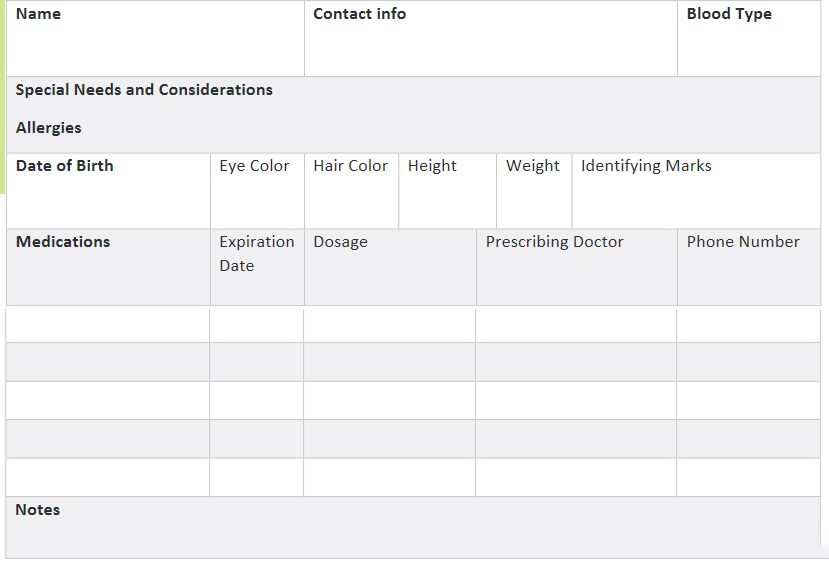
Home Hazard Hunt
 Take the checklist below and divide it into sections that are applicable for your household. Go room by room through the entire home. Don’t forget to include garages and yards. Check off each item and circle or highlight the things that need to be fixed. Make sure to work together, as a family, to address the hazards, going through one section at a time. During and right after a disaster, any household items that can move, fall, break, or cause a fire is a home hazard. At least once each year, inspect your home to find and correct potential hazards.
Take the checklist below and divide it into sections that are applicable for your household. Go room by room through the entire home. Don’t forget to include garages and yards. Check off each item and circle or highlight the things that need to be fixed. Make sure to work together, as a family, to address the hazards, going through one section at a time. During and right after a disaster, any household items that can move, fall, break, or cause a fire is a home hazard. At least once each year, inspect your home to find and correct potential hazards.
Identifying electrical hazards
- Check for electrical hazards
- Replace frayed or cracked extension and appliance cords, loose prongs and plugs.
- Make sure there is only one plug per outlet. Avoid using cube taps or overloading outlets. If you must use an extension cord, use a cord that’s rated for the electrical load and no longer than is really needed.
- Remove electrical cords that run under rugs or over nails, heaters, or pipes.
- Cover exposed outlets and wiring.
- Repair or replace appliances that overheat, short out, smoke or spark.
Check for chemical hazards
- Store flammable liquids such as gasoline, acetone, benzene and lacquer thinner in approved safety cans, away from the home. Place containers in a well-ventilated area and close the lids tightly. Secure the containers to prevent spills.
- If flammable materials must be stored in the home, use a storage can with an Underwriter’s Laboratories (UL) or Factory Mutual (FM) approved label. Move materials away from heat sources, open flames, gas appliances and children.
- Keep combustible liquids such as paint thinner, kerosene, charcoal lighter fluid and turpentine away from heat sources.
- Store oily waste and polishing rags in covered metal cans.
- Instruct family members not to use gasoline, benzene or other flammable fluids for starting fires or cleaning indoors.
Check for fire hazards
- Clear out old rags, papers, mattresses, broken furniture and other combustible materials. Move clothes, curtains, rags and paper goods away from electrical equipment, gas appliances or flammable materials.
- Remove dried grass cuttings, tree trimmings and weeds from the property.
- Clean and repair chimneys, flue pipes, vent connectors and gas vents.
- Keep heaters and candles away from curtains and furniture.
- Place portable heaters on level surfaces, away from high traffic areas. Purchase portable heaters equipped with automatic shutoff switches, and avoid the use of extension cords.
Check for structural hazards
- Water heaters, large appliances, bookcases, other tall and heavy furniture, shelves, mirrors, pictures, and overhead light fixtures have been anchored to wall studs
- Pictures or mirrors have been moved away from where people sleep or sit
- Large or heavy objects have been moved to lower shelves or stored somewhere else
- The water heater and other gas appliances have flexible gas supply lines
- Cabinet doors are latched or locked so that items cannot fall out
- Hallways and stairways are well lit
- Hallways and stairways are free of clutter
- Any deep cracks in ceilings or the foundation have been repaired
Hazards for small children
- Safety gates are at the bottom and top of stairways
- There are guards around fireplaces, radiators, hot pipes, or wood-burning stoves
- Sharp edges are cushioned with corner guards or other material
- Curtain cords and shade pulls are out of reach
- The hot water heater is set at a safe temperature (120 degrees or less)
- Prescription drugs and over-the-counter medicines are kept in childproof containers and out of reach
- Shampoos and cosmetics are kept out of reach
- All sharp objects in the bathroom, kitchen, and other areas are kept out of reach
- Toilet seats and lids are kept down when not in use
- Outlets are covered
- Beds or cribs are away from radiators or other hot surfaces
- Mattresses fit the sides of cribs snugly. The crib slats are no more than 2-3/8 inches apart
- Toy boxes have secure lids and safe-closing hinges
Safety Equipment
- Check fire safety equipment
- Install at least one smoke detector on each level of the home, especially near the bedrooms. Test every month and change batteries at least once a year.
- Keep at least one fire extinguisher (ABC type). Maintain and recharge according to manufacturer’s instructions. Show all family members where it’s kept and how to use it.
Secure Items
- Check items that can shift or fall
- Anchor water heater, large appliances, bookcases, tall or heavy furniture, shelves, mirrors and pictures to wall studs.
- Fit water heater with a flexible gas supply line.
- Place large or heavy objects on lower shelves.
- Install clips, latches or other locking devices on cabinet doors.
- Provide strong support and flexible connections on gas appliances.
- Brace overhead light fixtures.
- Hang heavy items such as pictures and mirrors away from beds and places where people sit.
- Repair any deep cracks in ceilings or foundations.
Utilities
- Check all utilities
- Locate the main electric fuse or circuit breaker box, water service shut-off and natural gas main shut-off.
- Contact local utility companies for instructions on how to turn off the utilities. Teach family members when and how to turn off utilities.
- Clear area around shut-off switches for easy access.
- Attach shut-off wrench or specialty tool to a pipe or other location close by the gas and water shut-off valves.
- Paint shut-off valves with white or fluorescent paint to increase visibility.
PRACTICING AND MAINTAINING YOUR PLAN
- Quiz family members often so they remember what to do.
- Conduct fi re and emergency evacuation drills.
- Practice the earthquake “Drop, Cover, and Hold On” protective action.
- Register and participate in the statewide Shake Out Day in April every year.
- Participate in community exercises and drills.
- Replace stored water every year and stored food every six months.
- Test and recharge your fi re extinguisher(s) per manufacturers’ instructions.
- Test your smoke and carbon monoxide detectors monthly and change the batteries at least once a year.
Your family preparedness is the most important part of the whole community concept because preparedness
begins with individuals and families, and goes out from there. YOU have a great role and responsibility to play when it comes to recovery and resilience, not only for your family, but for your workplace, the community, and the neighborhood which you live in.
TYING IT ALL TOGETHER
After following the preparedness steps: Get Informed, Make a Plan, Make a Kit, and Get Involved, it is important to fi nd out what you can improve upon and evaluate your efforts to make your personal recovery more successful.
Evaluation involves looking at performance to determine how it differs from expectations, and realizing
strengths and opportunities for improvement. Improvement involves a little planning and implementing needed changes to align performance with your goals and objectives of your family preparedness. Objectives should also be part of ongoing elements of your family’s and community’s overall preparedness effort.
Evaluation tells you whether your plans work. A plan may look good on paper, but until it is put into practice, you won’t really know whether your procedures are effective and feasible, and/or when family members and neighbors have been equipped with the capabilities they need to do the job of responding to an emergency. Objective evaluation lets you identify strengths and weakness of plans and actions, and identifi es potential problem areas that may have been overlooked.
THIS IS A GREAT TIME TO ASK YOURSELF QUESTIONS PERTAINING TO YOUR OVERALL
READINESS.
- Can we implement our plan effectively if an actual disaster happened tomorrow?
- What are the lessons we have learned from exercising our plans, playing games, and learning
more about preparedness? - How can we better close the gaps that make us not as prepared as we want to be?
- What actions can we take to make our preparedness and response capabilities more effi cient and effective?
Write down your answers and make an action plan of what you will work on before the next time
you practice your plan
When those questions are put to the test; you will know how you, your family, and neighborhood will fare. Preparedness is an ongoing process that should be continued to help instill a culture of preparedness within families and communities. There are so many resources that can be utilized to help with personal, family, work, worship, and community preparedness. Please take advantage of what is available to strengthen your family and neighborhood. Some resource links can be found at the end of the family preparedness guide and on www.readytooele.org or www.tcem.org.
Improving is the best part of the process because you can see where you have been, the progress you made and the areas that need work to help build better and stronger. When you take into account the lessons learned within the process, and start to share them and help others, a culture of preparedness can support neighborhood and whole community preparedness efforts and assists in the Emergency Management process.
NEIGHBORS HELPING NEIGHBORS
Neighbors Helping Neighbors is a simple way to prepare for emergencies such as an earthquake or other major disaster. It does not require any special expertise or knowledge – just a to help and be more prepared.
We invite you to meet with your neighbors to discuss these steps and follow them together. Making plans as neighbors allows help to be available immediately when the Professional First Responders are unable to come because EVERYONE needs help and they are taking care of other larger issues. Help will most likely come from neighbors who will need to rely on each other and rely on resources within the neighborhood.
Check out www.nhnpreparedness.com to learn how you can help your neighborhood by participating in a block captain neighborhood communication program.
Being involved with your neighbors and neighborhood will ultimately help the recovery process for you and your family happen more quickly. This section developed by Neighbors Helping Neighbors, is a simple, quick glance preparedness plan based on what you need one month at a time. This plan will get you on your way to preparing for the unexpected and to be able to help your neighborhood family. Disasters don’t end in an instant, so it is important to think about long term recovery and what that means for your neighborhood and community.
Month 1: Family Emergency Plan
Month 2: First Three Minutes
Month 3: First Three Hours
Month 4: First Three Days
Month 5: First Three Weeks
Month 6: First 3 months
MONTH 1: FAMILY EMERGENCY PLAN
Your family may not be together when disaster strikes, so it is important to plan in advance. Ask these questions: How will you contact on another? How will you get back together? What should we do in different situations? It is suggested that each family designate a person in another state as an emergency contact for all family members. Also exchange cellular, work, and home phone numbers. Know the names and needs of each family member, and include pets. Also, be aware of neighbor’s special needs or medical requirements. Keep this information readily accessible, such as posting inside a pantry door or with your GO kit. Where feasible, purchase battery operated family service radios and learn how to communicate with your neighbors.
MONTH 2: FIRST THREE MINUTES
3-minute kits attached to each bed in the house filled with sturdy shoes, flashlight, sturdy gloves, whistle, and lightweight clothes will enable persons to walk across the floor with light in case there is debris and power is out.
MONTH 3: FIRST THREE HOURS
The first three hours after a disaster are an important time to take stock of your situation. You might need to help a family member or neighbor who is injured. The most important item may be a well-stocked first-aid kit. Make sure you have adequate supplies, medications, and personal needs for each family member. Remember prescription medications! A battery operated AM/FM radio to listen for information from public safety agencies, supplies for needed rescue, and a binder with important documents should be accessed. Make sure you have extra batteries or a radio that runs off solar or a hand-cranked dynamo.
MONTH 4: FIRST THREE DAYS
If a disaster is large enough, it may cause interruption to community services over several days. Planning for the next three days will require you to organize food and water for family members. Here are some items you might need. Prepare a “72-hour kit” for each family member. Keep it packed and ready to “grab-and-go” at any time, in case you need to leave suddenly. Include water (at least 1 gallon per person per day), easy-to-prepare food items, clothing, shoes, first aid supplies, medications (including prescriptions), personal hygiene items, water filters or purification tablets, shelter and survival supplies, and cash in small denominations. Place these kits in an easily-accessible location in your home and show family members where they are stored. Involve the family in gathering the family supplies.
MONTH 5: FIRST THREE WEEKS
A major disaster may cause disruption of services like stores and utilities over an extended time. It’s time to prepare for the fi rst three weeks. Don’t worry, it’s not as overwhelming as it might sound. In addition to the supplies you’ve put away for the fi rst three days, continue adding enough water, food, and personal items to last three weeks. The simplest way to accomplish this preparation is over time. Each time you go shopping, purchase a little extra of the same food and personal items you normally buy. For water storage, consider some larger containers, like 5-, 15-, 30-, or even 55-gallon water storage barrels. Also consider other cooking methods and power and fuel options that you will be able to use if the disruptions lasts longer than you think it might.
MONTH 6: FIRST THREE MONTHS
Our next preparation time-period is the most daunting – three months. Hopefully, none of us will ever experience a post-disaster period where we need to rely on our own supplies for three months, but it could happen. Examples are a job loss, health problems, or loss of a family member. Never does anyone want this to happen, but if it does and you are adequately prepared the event won’t feel as stressful because you will have prepared in advance to take care of your family needs. Continue to build up an adequate supply of food that is part of your normal, daily diet. Work toward storing enough to feed every family member for three months. Include a combination of basic food-storage staples (like flour, beans, and rice) as well as everyday food that is easily prepared. Build this supply up gradually, and you won’t be overwhelmed by the task.
Disasters can range from inconvenient to devastating, but taking some simple preparedness steps in advance can minimize their impact and make a big difference in ensuring the safety and well-being of individuals, families, businesses and communities.
Being prepared can reduce the fear, anxiety and losses that accompany disasters. Communities, families, and individuals should know what to do. You should know how to respond to severe weather or any disaster that could occur in your area, including earthquakes, wildfi res, landslides, pandemic, flooding, terrorism and more. You should also be ready to be self-suffi cient for three to seven days. This may mean providing for your own shelter, fi rst aid, food, water and sanitation.
Think of the national emergency management system as a pyramid with you, the citizen, forming the base of the structure. The community, the state, and the national government also have roles.
You have a responsibility to protect yourself and your family by knowing what to do before, during and after an event. Doing your part helps your community, county, and state be able to do their part more effectively and in turn everyone benefits.
TOOELE READY QUICK RECAP
Before an Emergency:
- Know the risks and danger signs of potential emergencies.
- Sign up to receive notifi cations on www.readytooele.org or on Tooele County Emergency Management’s Facebook page.
- Reassess your insurance, possibly including earthquake and/or fl ood insurance (not part of your homeowner’s policy).
- Develop plans for what you and your family should do in case of emergency.
- Assemble an emergency kit with supplies for every member of your household, including pets.
- Learn from other emergencies and disasters and include the lessons learned into your planning.
- Volunteer to help others in your community as you are able. Sign up to be a part of Tooele Responds.
During an Emergency:
- Put your emergency plan into action.
- Help others as you are able.
- Follow the advice and guidance of offi cials.
After an Emergency:
- Repair damaged property.
- File insurance claims if necessary.
- Take steps to prevent or reduce future loss.
- Reassess your emergency plan and make appropriate changes
- elp your community with recovery.
